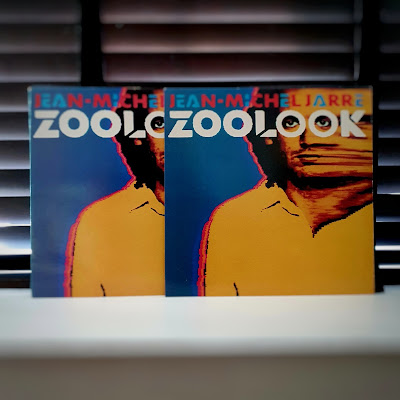I bought the record on the left of this picture over thirty five years ago. Unfortunately the years haven't been kind to the disc so I recently bought another copy in better condition.
When I moved from vinyl to CD I kept my original record because it was the easiest way to hear the original versions of two tracks from the album.
About a year after "Zoolok" was released, someone decided that the single mixes of the title track and "Zoolookologie" were superior to René Ameline's original efforts. As a result, all subsequent pressings of the CD and cassette would include these remixes. Discogs suggests there were no re-pressings of the UK LP, so until the age of the internet, this first version was the cheapest way of owning the original mixes.
When I first heard this album I was struck by how different it was to "Equinoxe", "Magnetic Fields" and "Rendez-Vous". Part of the folklore of this album is that during his travels around the
world, Jarre made field recordings that were subsequently incorporated into the
music. In addition French ethnologist, Xavier Bellanger contributed a
large number of recordings of speech in various languages that Jarre
processed and wove into the fabric of the record. Yet, like many things
Jarre does, these claims don't bear much scrutiny. There are a number of
vocal samples that are easily identified as belonging to the sample
libraries for the Fairlight CMI and the Emu Emulator, and some
recordings were of Jarre and the other musicians who contributed to the
recording sessions.
The first movement of opening track "Ethnicolor" uses a distinctive reversed vocal sample over a choir and melody played on the "Tut" sample from the EMU Emulator library. This track also significant because it features the only discernable use of a Yamaha DX7 in Jarre's music. Whilst the whole world was plastering their recordings with this FM synthesiser in 1984, Jarre didn't really like it and so a small scattering of tubular bells is all you will hear in his music. After about seven minutes the second movement is ushered in by French horns and various sound effects. Soon the drums of Yogi Horton come crashing through with the distinctive slap bass of Marcus Miller rattling around under the increasingly frenetic samples and synths.
In 1983 Jarre auctioned a solitary copy of an album called "Music For Supermarkets". Rather than waste the material from that record, Jarre decided to recycle some of it here. Second track "Diva" begins as an atmospheric piece in which Laurie Anderson adds various nonsensical words that sound vaguely Gallic. Before long the track moves into a second movement that echoes "Music For Supermarkets Part VII". The principal difference in the version here is that Anderson continues with her gibberish vocals and there is some guitar courtesy of Adrian Belew.
The titicular single begins side B with a nice theme played on the "AAH" sample found in the Fairlight sample library. Various vocal snippets float in and out as the slap bass chugs along. As the lead single for the album I always feel like I should like this track, but it doesn't really excite me as much as it should.
"Wooloomooloo" is based around a looped sample (I seem to remember it is called something like "Tibet" in the Fairlight) that staggers along as Jarre adds a melody and lots of effects. The single "Zoolookologie" is an upbeat and frivolous pop song that was accompanied by a video that was so bad it might actually be good. The tune is pleasant enough and for once the slap bass is restrained sufficiently to not dominate the mix.
Once again Jarre plunders "Music For Super Markets" as "Part V" is reincarnated as "Blah Blah Cafe". Here, Emulator saxophones create funky melodies with quirky vocoder vocals soaring over pitched down drum samples. It's a heady, but effective concoction. The final track "Ethnicolor II" is another slower piece based on a looped sample. There are various effects moving in and out as a meandering melody is played out on cello samples.
To me this album sounds a bit like Jarre fell in love with the Emulator and decided to build an album around it. By creating some themes, bringing in some new musicians and recycling bits of "Music For Supermarkets" there was just enough to hang these new sounds on. Whilst it was a valiant effort, this record is not one of his best. 3/5





















